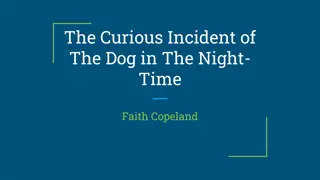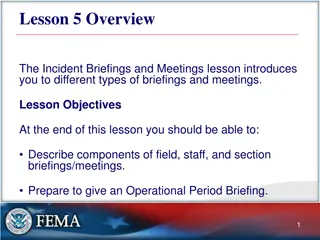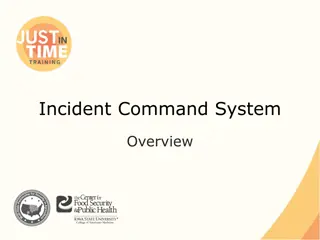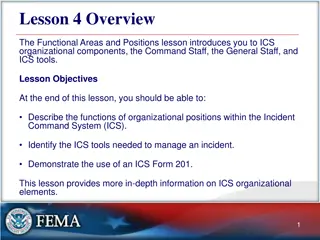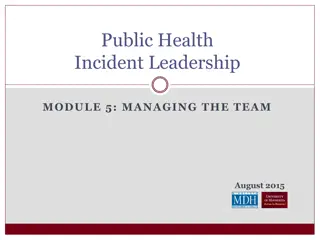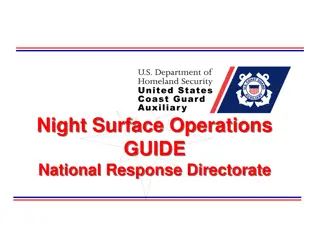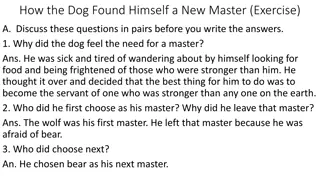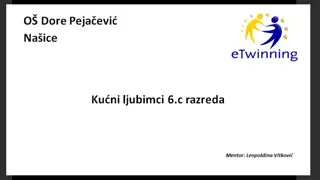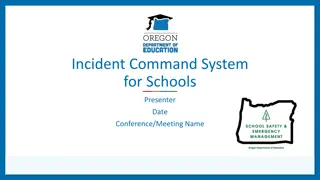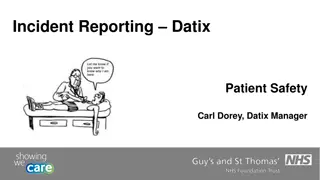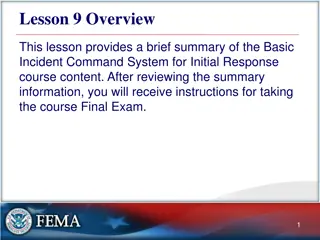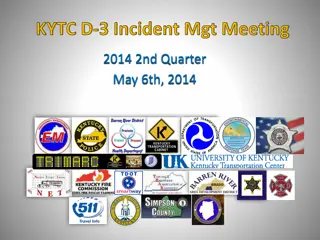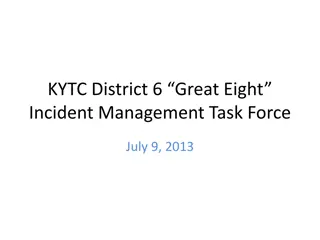Exploring 'The Curious Incident of the Dog in the Night-Time' Narrative Design
A deep dive into the story of "The Curious Incident of the Dog in the Night-Time," focusing on characterisation, context, themes, author biography, novel format, writer's intentions, motifs, symbolism, and adaptations. The novel follows Christopher Boone, a 15-year-old with Asperger's Syndrome, as he investigates the murder of a neighbor's dog and uncovers secrets about his family and the world around him.
Download Presentation

Please find below an Image/Link to download the presentation.
The content on the website is provided AS IS for your information and personal use only. It may not be sold, licensed, or shared on other websites without obtaining consent from the author. Download presentation by click this link. If you encounter any issues during the download, it is possible that the publisher has removed the file from their server.
E N D
Presentation Transcript
CONTENTS The Curious Incident of the Dog in the Night-Time Resource Pack Objective: to evaluate the story design of novel with in-depth insight and interpretation Characterisation Synopsis Context Themes Author biography Novel format Writer s intentions Motifs, symbolism and dramatic devices Adaptations PEEL response Key quotations Assessment scaffolds
Christopher John Francis Boone Ed Boone Judy Boone (Chris s Mother) Mrs Shears (Eileen Shears) Mr Shears (Roger Shears) (Christopher s Father) Christopher s father, single (widowed or divorced). Ed looks after his son and seems to be patient in tending to his special needs. However, there are many secrets that he hides from his son: about Wellington, Chris mother, the neighbours and his temper. He also has a boiler repair and heating maintenance business. Roger Shears ex-wife is a neighbour of Christopher s. She would visit the Boones, cook and play Scrabble. This all occurred after Christopher s mother allegedly died. Her dog is murdered at the start of the novel, acting as the catalyst for the rest of the story, prompting Christopher to start a vigilante investigation into the enigma of the dog s death. First person narrator of novel a fifteen-year-old kid with Asperger s Syndrome and a gift at advanced mathematics. He is literal and blunt when retelling events. He has obsessive likes and dislikes who loves logic and order, solving puzzles (like Wellington s murder), lives with his father at 36 Randolph Street and believes his mother died. Christopher s mum is apparently dead. He believes she died from a heart attack and remembered her as a caring but erratic mother who became increasingly frustrated with the quirks of Christopher s condition. The truth about Christopher s mum may be quite different to what he has been told. Eileen s ex-husband. He used to work at a town bank but moved to London two years ago, leaving Mrs Shears. Christopher found his departure puzzling and decides to investigate him as a possible murder suspect in the case of Wellington s death.. Siobhan Christopher s primary school teacher. A well-adjusted mentor who helps Chris integrate. One of the few people Chris trusts. Mrs Alexander an elderly neighbour on Randolph street. A quiet, pleasant lady who loves gardening and her pet dachshund Ivor. She reveals important information about Christopher s father and mother and treats Chris like a grandson. Wellington Mrs Shears murdered black poodle. The story begins with Wellington impaled on a pitchfork. Toby Christopher s pet rat. He is a companion to Christopher and joins him on his venture to London when he tries to escape from his father. Christopher treats Toby as if he was a family member.. Mr Jeavons - A middle-aged man and the psychologist at Christopher s school. Rhodri - Father s unpleasant co-worker. He likes to mock Christopher and will set near- impossible maths questions for him, for his own enjoyment. Much to Chris irritation, Rhodri helps Chris father blow off steam. Julie - Chris first primary school teacher. Uncle Terry - A Sunderland factory worker (Ed s brother). Reverend Peters - A vicar (Mrs. Peters s husband). Agrees to be invigilator for Christopher s A-level maths exam. Mrs. Gascoyne - Christopher s school principal who agrees to let Chris take his A-level maths exam. Mr. Thompson - Resident of Randolph Street whom Chris interviews. Mr. Wise - another interviewed Randolph Street resident. Mr Wise lives with his disabled mother.
SYNOPSIS NARRATIVE CONTEXT In 1998, Swindon, England, a fifteen-year-old boy with Asperger s Syndrome called Christopher Boone narrates a tale that begins with the death of a neighbour s poodle impaled with a pitchfork. He begins a murder investigation that causes his father to ban him from hassling the neighbours with questioning, as he writes down in findings in a book as if it s a school assignment. The plot becomes increasingly complicated when his father and the owner of the dead dog (Mrs Shears) had a romantic affair. This leads to the finding that Mr Shears had an affair with Christopher s mother prior to this and that his mum is not dead, just in London living with Mr Shears. He finds hidden letters addressed to him from mother which father kept secret. He is also preparing for an A-level maths exam well ahead of time but becomes tangled in a pursuit to find his mum after realising his father might be the dog s killer. His journey from Swindon to London by train leads to chaos. Christopher s condition cannot cope easily with the outside world, dodging police, trying to find his way whilst being overwhelmed by a variety of inner-city signs and slogans. Christopher eventually moves in with his mother but this causes friction with Mr Shears. They eventually separate as a result and Chris settles in with father visiting on occasions. He takes his A-Level exam and gets an A grade. He solved the murder, found his mother and wrote this amazing book. First person narrator Christopher. Style of narration First person with obsessive focus on facts and statistics. Setting A middle-class area of Swindon in the mid-90s and central London. Premise Christopher is trying to investigate the murder of Mrs Shears dog but ends up discovering secrets about his family and neighbourhood as a result. Conflict Christopher s Asperger s Syndrome is both a blessing and a curse. He has an exceptional ability in subjects like Maths and Physics but struggles to communicate with others and the world around him. This particularly frustrates his parents, who have learned how to respond to Chris for instance, an awareness that physical contact will lead to extreme reactions. Chris is also struggling to trust his father after finding out shocking secrets about the lies he has been told throughout his life. MARK HADDON BIOGRAPHY KEY THEMES AND NARRATIVE TOPICS Mark Haddon was born in Northampton in 1962. He graduated from Oxford University in 1981, returning later to study for an M.Sc. in English Literature at Edinburgh University. He then undertook a variety of jobs, including work with children and adults with mental and physical disabilities. He also worked as an illustrator for magazines and a cartoonist for New Statesman, The Spectator,Private Eye, the Sunday Telegraphand The Guardian. His first book for children, Gilbert's Gobstopper, appeared in 1987 and was followed by many other books and picture books for children. In 2003 his novel, The Curious Incident of the Dog in the Night-Time,was published and has been hugely successful. It is the first book to have been published simultaneously in two imprints - one for children and one for adults. Mark Haddon teaches creative writing for the Arvon Foundation and Oxford University. The bias of personal experience The struggle for independence Chaos vs. routine Coping with loss Asperger s Syndrome Approaches to parenting Logic and reason Secrets Maths equations and A-level tests The murder investigation Long lists of facts and statistics Swearing and blunt language Neighbourhoods and community Naivety Forgiveness Vigilante justice Adolescence Mainstream society
THE NOVEL FORMAT THE WRITER S INTENTIONS Idiosyncrasies of a narrative voice in order to illustrate traits of Asperger s syndrome A celebration of the importance of Mathematics as a subject The writer s ideology care and compassion for misunderstood outsiders Representation of the brutal realities of the real world Use of prime number chapters to highlight Christopher s love of mathematics Development of enigmas and catalysts mysteries and conflicts surrounding his parents Helping readers to understand the nature of Asperger s Syndrome The non-linear narrative structure - no exposition before the first incident (Stage 2/5 of narrative before Stage 1/5) An empathy for the quirks of human behaviour, hobbies and specialisms Stressing the importance of responsible and trustworthy parenting The design of complex characterisation no simplistic heroes and villains. The purpose of telling the story from Chris s POV A refusal to censor blunt language for young readers MOTIFS, SYMBOLISM AND DRAMATIC DEVICES ADAPTATIONS OF THE NOVEL West End Play at the Gielgud Theatre, Shaftesbury Avenue (Central London) originally starring Luke Treadaway as Christopher it has won awards at the Oliviers for Best New Play and Best Actor and has stayed on the West End for three years consecutively. Prime numbers Dead dog impaled by pitchfork Foreshadowing events Letters Maths equations, maps, lists, facts, statistics and diagrams Enigmas and catalysts Blunt descriptions of going to the toilet Signs and symbols in the city Swearing and foul language Middle-class homes Detectives and police officers Toy train sets Pet rat Dogs The supernatural Impatience and frustration
Example question: How has Haddon used language in order to convey Christopher s character in Chapter 211? Point Evidence Explain Link Hadden uses blunt language through Christopher s narration in order to show how Christopher does not have a filter for offensive content spoken by other people. One example of this is Rather than censoring others in his retelling, he simply dictates their dialogue word- for-word. This highlights how Christopher does not understand social cues and the need for euphemisms to soften the content of what is being expressed. Hadden uses co-ordinating conjunctions through Christopher s narration to illustrate the effect of Asperger s Syndrome on how he describes things. This is illustrated when he says This gives the impression that Haddon s characterisation of Christopher is profoundly expressed through the narrative style. We have a greater understanding of Christopher because of the first person approach of the novel. Haddon represents Christopher s condition through very literal descriptions of events such as when he says The writer s purpose is to This represents Christopher s condition because Haddon adds long lists of facts and statistics through Christopher s narration, forinstance, This emphasises how Haddon intends to convey s Christopher s Haddon rarely has Christopher using metaphors describing them as because Haddon s depiction of Christopher is
Official Online Example Curious Incident Set Questions To Consider: To what extent is Christopher s condition responsible for the conflicts that arise in The Curious Incident of the Dog in the Night-time? Christopher s condition causes him to see the world in a very subjective way, and as a result the reader may often interpret events differently than Christopher does. What role does this difference between Christopher s understanding of events and the reader s understanding of events play in the novel? Christopher employs a number pictographs drawings, maps, and figures over the course of his narrative. What are the key pictographs in the novel? How does Christopher uses them? What insight does it grant into his character? Think of the novel as narrated in the third person, instead of by Christopher. How would this change affect our views of the characters and the emotional impact of the novel? Christopher quotes Mother as saying that his behaviour would drive her to an early grave. Citing evidence from the text, to what extent does Christopher feel responsible for Mother s death ? Do her letters and eventual reappearance change how he feels? What are the significant ways in which Christopher s character has and has not changed over the course of the novel? Christopher appears to believe in always acting logically. Does Christopher always behave logically, and what does this tell us about his character? What is Siobhan's role in the novel? Discuss the first person narrative employed by Haddon to portray the novel from Christopher's perspective. Given Christopher's aversion to being touched, can he experience his parents' love for him, or can he only understand it as a fact, because they tell him they love him? Is there any evidence in the novel that he experiences a sense of attachment to other people? What challenges does The Curious Incident present to the ways we usually think and talk about characters in novels? How does it force us to re-examine our normal ideas about love and desire, which are often the driving forces in fiction? Since Mark Haddon has chosen to make us see the world through Christopher's eyes, what does he help us discover about ourselves? How does your experience reading this book relate to a quote Christopher likes from The Hound of the Baskervilles: "The world is full of obvious things which nobody by chance ever observes" (p. 73)? Christopher Boone finds lies confusing. He believes that metaphors and novels are lies, and he clams he "can't tell lies" (p. 19). In fact, he declares, " everything I have written here is true" (p. 20). How reliable is this narrator?
Important quotations throughout the novel which could be used for your final assessment: UNDERSTANDING COMMUNICATION I like dogs. You always know what a dog is thinking. It has four moods. Happy, sad, cross and concentrating. (5.2) LOGIC AND LITERAL This will not be a funny book. I cannot tell jokes because I do not understand them. (13.1) REASSURING FAMILIARITY - This made me feel a lot calmer because it is what policemen say on television and in films. (17.2) A MATHEMATICAL MIND - Prime numbers are what is left when you have taken all the patterns away. I think prime numbers are like life. They are very logical but you could never work out the rules, even if you spent all your time thinking about them. (19.6) COPING WITH PHYSICAL CONTACT - He held up his right hand and spread his fingers out in a fan. I held up my left hand and spread my fingers out in a fan and we made our fingers and thumbs touch each other. We do this because sometimes Father wants to give me a hug, but I do not like hugging people, so we do this instead, and it means that he loves me. (31.5) BEING OVERWHELMED BY THOUGHTS - And if I start thinking about something which didn't happen I start thinking about all the other things which didn't happen. (37.3) CONSIDERING FAITH, SPIRITUALITY AND THE AFTERLIFE USING LOGIC - I think people believe in heaven because they don't like the idea of dying, because they want to carry on living and they don't like the idea that other people will move into their house and put their things into the rubbish. (61.6) CAREER AND LIFE PLAN/AMBITION - Then, when I've got a degree in Maths, or Physics, or Maths and Physics, I will be able to get a job and earn lots of money and I will be able to pay someone who can look after me and cook my meals and wash my clothes, or I will get a lady to marry me and be my wife and she can look after me so I can have company and not be on my own. (71.8) THE NEED FOR ORDER AND ROUTINE DUE TO HIS CONDITION It is permitted to move the chairs and the table in the kitchen because this is different but it makes me feel dizzy and sick if someone has moved the sofa and the chairs around in the living room or the dining room. (73.2) PARENTS IMPATIENT WITH CHRISTOPHER S CONDITION - Sometimes Father would say, "Christopher, if you do not behave I swear I shall knock the living daylights out of you," or Mother would say, "Jesus, Christopher, I am seriously considering putting you into a home," or Mother would say, "You are going to drive me into an early grave." (73.4) CHRISTOPHER S INTEGRITY And she said, "Are you telling the truth, Christopher? And then I said, "I always tell the truth. (109.10-12) LEARNING TO UNDERSTAND LANGUAGE This is what Siobhan says is called a rhetorical question. It has a question mark at the end, but you are not meant to answer it because the person who is asking it already knows the answer. It is difficult to spot a rhetorical question. (127.15) CHRISTOPHER S GIFT WITH LOGIC AND SUBJECTS WITH FACTS, STATISTICS AND EQUATIONS Because I decided that it was a kind of puzzle, and if something is a puzzle there is always a way of solving it. (163.8) FEAR AND RISK - And then I realised that there was nothing I could do which felt safe. [...] (179.23) STRATEGISING - And then I Formulated a Plan. And that made me feel better because there was something in my head that had an order and a pattern and I just had to follow the instructions one after the other. (179.30) TRANSLATING THE OUTSIDE WORLD - And then the next train came I wasn't so scared any more because the sign said TRAIN APPROACHING so I knew it was going to happen. (227.8)
Additional Help Sheet Sentence starters Language devices to consider in Haddon s novel Co-ordinating conjunctions Mark Haddon uses first person narration to show how Christopher is Swearing and blunt language Literal description Statistical detail Facts and opinions First person narration Dialogue Long lists of information Bold, uppercase, italics Emotive language and hyperbole Similes Powerful verbs and adjectives Christopher uses literal descriptions of events because The repeated use of co-ordinating conjunctions such as illustrates that Helpful connectives and sentence starters you could use: Firstly Similarly On the other hand The effect of this choice is In conclusion One might argue that Consequently As a result In contrast The writer s purpose is However This shows that This illustrates that This gives the impression that This highlights that Therefore Helpful mid-sentence connectives to shows illustrates depicts emphasises connotes points out links represents proves defines contrasts conveys expresses gives the impression portrays differs
Assessment Focus Areas In Detail AF2: Understanding and using quotations Developing I can identify most relevant points clearly, including those from different places in the text and my comments are generally supported by relevant evidence. Secure I identify relevant points clearly, including summary and synthesis of information incorporating apt textual reference and evidence. Exceeding Precise selection and use of quotations and using wider knowledge to develop your argument. AF3: Inferring Developing I can develop explanation of inferred meanings based on textual evidence. Secure My comments are securely based in textual evidence and identify layers of meaning, with some attempts at detailed explanation. Exceeding Develop an interpretation by considering the relative importance of different pieces of evidence, even exploring what is left unsaid. AF5: Language Developing I can identify a range of language techniques and add some explanation of their effect on the reader. Secure Detailed analysis, with correct terminology, of how language is used and some analysis of its overall effect on the reader. Exceeding Develop a precise and perceptive analysis of how language is used and appreciate how language choices contribute towards the overall effect on the reader. AF7: Context Developing I can explain how the text relates to its context. Secure Some detailed discussion of how the context of the text is linked to its meaning. Exceeding A thoughtful analysis of how the context of the text links to how it was written and/or how it is interpreted by the reader.
Core Assessment Question How does Haddon represent Christopher through his narration and how does Haddon make the reader feel about Christopher s family?


